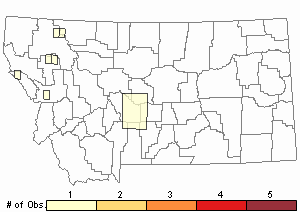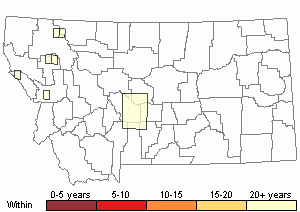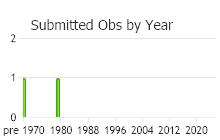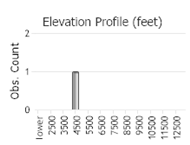View in other NatureServe Network Field Guides
NatureServe
Montana
Utah
Wyoming
Idaho
Wisconsin
British Columbia
South Carolina
Yukon
California
New York
A Boat Moss - Hygrohypnum duriusculum
Other Names:
A Hygrohypnum Moss,
Hygrohypnum dilatatum
General Description
Plants: Pleurocarpous, green with yellow tones, olivaceous, or brownish yellow, sometimes dappled with russet, rough and somewhat rigid. Stems sometimes reaching 7 cm, freely branching, either leafy below or often leaves stripped along the stem base, lacking a hyalodermis and possessing a robust central strand; paraphyllia lacking (FNA 2014).
Leaves: Often turned to one side, shriveled, straight, bent and twisted, or angled away from the stem 45 degrees or more when dry, lightly resting next to the stem and overlapping, occasionally turned to one side, bent or twisted when moist, 0.8-2.2 mm in length, 0.6-1.7 mm in width, flat or slightly cupped, not pleated, very widely egg-shaped to circular, or occasionally not so widely egg-shaped, narrowing to an acute or slightly wider-angled apex or short acumen; leaf edges typically smooth, seldom toothed, flat or curved back and downward below, occasionally rolled inward when dry; costa typically paired and both arms extending to halfway up the leaf, sometimes solitary, forked and extending past the middle (FNA 2014).
Leaf Cells: Medial cells short or long, narrow and tapering at both ends to linear and slightly bent, longer than the apical cells; margins unbordered, the cells seldom more than 55 micrometers in length; alar cells short and oblong to square, acquiring more color with age, thick-walled, the alar area distinct from adjacent regions (FNA 2014).
Diagnostic Characteristics
Hygrohypnum duriusculum is part of a group of confusing species, including Hygrohypnum bestii and Hygrohypnum molle (FNA 2014).
The very long marginal cells (typically over 60 micrometers and sometimes exceeding 90 micrometers) separate the similar Hygrohypnum bestii from H. duriusculum and H. molle. The marginal cells of the latter two species rarely exceed 55 micrometers or seldom reach 60 micrometers respectively (FNA 2014).
H. duriusculum has a very distinct alar region, with cells square to short-rectangular, frequently pigmented, and thick-walled. It also has leaves that vary from straight to secund, contorted, spreading, appressed and overlapping. The alar region of H. molle is not particularly distinct from the adjacent cells, and its leaves are mostly fairly straight and lightly overlapping (FNA 2014).
Range Comments
North American Range
Canada: BC and AB, ON to NS and NL; USA: AK, MT s to NM and the states west of that boundary (except unknown in OR), also NY to ME, VA, TN, and NC (FNA 2014). Known in Montana from Cascade, Glacier, Lake, and Missoula Counties (Elliott and Pipp 2016).
Observations in Montana Natural Heritage Program Database
Number of Observations: 7
(Click on the following maps and charts to see full sized version)
Map Help and Descriptions
Relative Density

Recency



 (Observations spanning multiple months or years are excluded from time charts)
(Observations spanning multiple months or years are excluded from time charts)
Habitat
Wet, non-basic stone in mountain streams. Ranging from lowlands to 11,810 feet elevation (FNA 2014).)
Reproductive Characteristics
Autoicous. Seta red, sometimes with yellow or purple tones, 9-24 mm tall. Capsule upright and somewhat bowed (FNA 2014).
Stewardship Responsibility
References
- Literature Cited AboveLegend:
 View Online Publication
View Online Publication Elliott, J.C. and A.K. Pipp. 2018. A Checklist of Montana Mosses (1880-2018). Updated 3 January, 2020. Montana Natural Heritage Program, Helena, Montana. 73 pp.
Elliott, J.C. and A.K. Pipp. 2018. A Checklist of Montana Mosses (1880-2018). Updated 3 January, 2020. Montana Natural Heritage Program, Helena, Montana. 73 pp. Flora of North America Editorial Committee, eds. 2014. Flora of North America North of Mexico. Volume 28. Bryophytes: Mosses, Part 2. Oxford University Press, Inc., NY. xxi + 702 pp.
Flora of North America Editorial Committee, eds. 2014. Flora of North America North of Mexico. Volume 28. Bryophytes: Mosses, Part 2. Oxford University Press, Inc., NY. xxi + 702 pp.
- Additional ReferencesLegend:
 View Online Publication
View Online Publication
Do you know of a citation we're missing? Elliot, J. C. 1993. Second checklist of Montana mosses. Unpublished report. U.S. Forest Service, Region 1. Missoula, MT. 45 pp.
Elliot, J. C. 1993. Second checklist of Montana mosses. Unpublished report. U.S. Forest Service, Region 1. Missoula, MT. 45 pp. Lawton, E. 1971. Keys for the Identification of the Mosses on the Pacific Northwest. Reprinted from 'Moss Flora of the Pacific Northwest'. Published as Supplement No. 2 of the Journal of the Hattori Botanical Laboratory. Nichinan, Miyazaki, Japan. 66 pp.
Lawton, E. 1971. Keys for the Identification of the Mosses on the Pacific Northwest. Reprinted from 'Moss Flora of the Pacific Northwest'. Published as Supplement No. 2 of the Journal of the Hattori Botanical Laboratory. Nichinan, Miyazaki, Japan. 66 pp. Lawton, E. 1971. Moss Flora of the Pacific Northwest. Hattori Botanical Laboratory. Japan: Yamabuki-cho, Shinjuku-ku, Tokyo. 362 pages plus appendices.
Lawton, E. 1971. Moss Flora of the Pacific Northwest. Hattori Botanical Laboratory. Japan: Yamabuki-cho, Shinjuku-ku, Tokyo. 362 pages plus appendices.
- Web Search Engines for Articles on "A Boat Moss"





